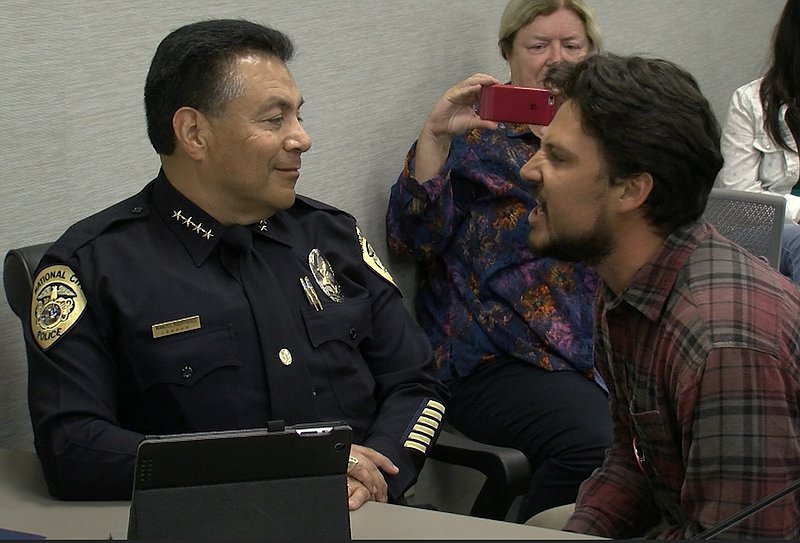Earl McNeil’s family is demanding answers from the National City, California, police department.

In the early morning hours of Saturday, May 26, Earl McNeil, a 40-year-old African American man with a history of mental health issues, walked up to the telephone attached to the front of the police department building in National City, California. According to police, McNeil told the dispatchers on the other end of the phone that he was high, had a warrant out for his arrest, and “wanted to kill Jesus.”
The National City Police Department is housed in an imposing concrete building on National City Boulevard, the main thoroughfare of the low-income, a predominantly Latinx city that sits just to the south of San Diego, and a little more than 10 miles from the U.S.-Mexico border. It was a few miles from where McNeil had been living, according to his relatives. Prompted by the conversation with dispatchers, officers met McNeil outside the police station, and soon after arrested him on suspicion of being under the influence of drugs.
When McNeil was taken out of the station several hours later, he was secured in the stiff nylon blanket and restraints known by police officers as the “WRAP.” Officers put him in the back of a police car to check him into San Diego Central Jail for processing. But by the time he arrived at the jail, McNeil was in medical distress, and he died 16 days later.
His death has sparked an outcry from family members and community activists who have demanded more information from the police about the circumstances of his death.

An unexplained death
McNeil’s family is desperate for answers about what happened on May 26. According to a spokesperson from the San Diego Sheriff’s Department, McNeil was “rejected” for booking by the sheriff’s department, and remained in the custody of the police department. “The Sheriff’s Department cannot comment on what may or may not have transpired while he was in the custody of NCPD,” the spokesperson told The Appeal. After he was rejected by central booking, paramedics were called to assist him — and McNeil lost consciousness soon after they arrived, according to a statement released by the police department.

But the police have released limited details about the incident, despite a growing public outcry — nobody camera footage, no names of officers involved in McNeil’s arrest, no surveillance footage from the precinct itself. The results of McNeil’s autopsy have yet to be released to the family, although the police chief told the San Diego Union-Tribune that preliminary information from investigators present during the autopsy found that there was no trauma on McNeil’s body.
McNeil’s family isn’t so sure. Photos they took while he was in the hospital show bruises to his head and lacerations to his body that they believe were caused at some point during the hours he was in National City police custody.
In the statement released in the days following McNeil’s death, the police said that McNeil was “intentionally hurting himself” during the trip to the county jail, despite being confined to the WRAP. The police did not respond directly to the family’s allegations or to a request for comment from The Appeal.
Tammy Davis, McNeil’s aunt, said she had to leave a meeting with the police chief, Manuel Rodriguez, because he kept smiling, and he refused to apologize for or elaborate on what happened to McNeil when he was in custody.
“There was a smile on the chief’s face and he was shaking his head. Every question we asked, he couldn’t give an answer,” Davis said. “He had a smile on his face from the time we started the meeting to the time we left the meeting.” Rodriguez did not respond to requests for comment.
At a City Council meeting on June 19, Rodriguez listened to comments from community members with a visible smirk on his face, enraging advocates and McNeil’s family members (Rodriguez disputes that he was smirking and instead says he was just trying to keep a “calm” face.) At the same City Council meeting, Tasha Williamson, a community activist who has been working with the McNeil family, was arrested after she went over her allotted speaking time and refused to leave the podium.
She said the police’s assertion that he hurt himself is ridiculous. “I was horrified by their statements because we had actually gone to the hospital the day they pulled the plug and saw his body,” Williamson said. She wants to know why they won’t release footage from his time in custody. “It just feels like a cover-up. It feels like they think we’ll go away.”
All body camera footage captured by the National City police is accessible by the San Diego district attorney’s office. The police department’s policy for officer-involved shootings is not to release the video “until the district attorney’s independent review of the incident has been completed and the findings have been provided to the law enforcement agency involved.” The police department could not confirm if the same policy applies to surveillance footage, or whether there’s a different policy for incidents involving arrestees injured while in custody.
Last month in Sacramento, police released body camera video of a man who died in police custody just a week after his death and released extensive surveillance footage within the month.

A Distressed Man Came to a Police Station Looking for Help. Hours Later, He Was In a Coma.



















